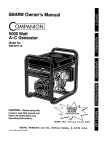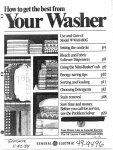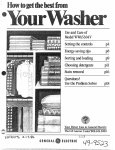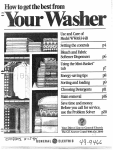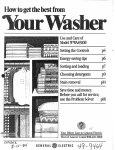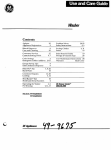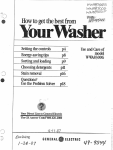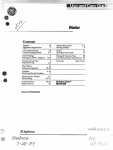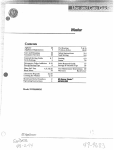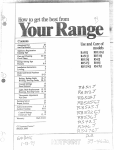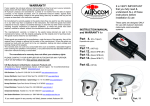Download GE WWA80729AL Washer User Manual
Transcript
%
togetthebestfrom
.—
useandcare
of’
Model
m A8072yflL~ Setingthecontrols
p4
Bleach
andFabtic
‘
Softener
Dispensers
p$
UshgtheMhi-BaskeP
~..-. ,,,
-. )?
.-.4
,’(
tub
p9
Ener~-saving
tips
plo
SortingandIoadng
Jy
choosingdetergenE
pl~
Swnremoval
p18
;r -.
,.
““.....)
fj
Savetimeandmoney
Beforeyoucd forsemice,
usetheProblem
Solver p20
220 Volt,soHertz
(yJ
/’%
HelpU!S
safety
!hlstiwctkms , ...... ...34’
●
How WICqxmte”y(w
washer
.. . .. .. .. . .. .. ..
. ...43
use bleachand
How to
fabric softenerdispensers . . . . . ..$3
How to useMini-Ek3sket~~
It is intendedto h;lp you operate
and maintain your new washer
properly.
Keep it handy for answers to your
questions.
You’llfind them on a label on the
lower left side near the front.
Please write these numbers here:
Model No.
Serial No.
‘Usethese numbers in any
correspondenceor servicecalls
concerning your washer.
M you received a damaged
washer9immediatelycontact the
dealer (or builder) that sokl you
the washer.
Save time and money...
befulire
you WRn
for service
Check the Problem Solver(pages
20-25). R.lists minor causes of
operating problems that you can
correct yourself. It could save you
an unnecessary servicecall.
Einergy-savingtips.. . . . . ... . ...10
God sorti~gmemsbetter
washin=
~. . . . . . . . . . . . . . . . ... . . . 11,
Rpaystocheckand
““
pretreat, =. . . . . . . . ..= . . . . . . ..ll
Soaking . . . . . . . . . . . . . ..-.S.H.H
~
,Ek9wt
GIoadyoutiwa&r . ..t..12
Whatisthebest sti;load - ‘ ‘- “
ti
ofck?thes. . . . . . . . . . . ..”......
Factc9rstocomickxin
selectionof detergents ‘~
andsoap . . : . . . . . . . . . . . ... . . ..13
Results of continued US4
ofcarbonati dettirgents . .-.....14
Howmuchdetergent orsoap-- SI’loukiyouu seq,.”.: . . . .. e.....15 ,
How to usedetergent
Cmscwp
. . . . . . . . . . . .. $......
●.15
Hard water—doyou
haveit . . . . . . . . . . . . . . . . . . . . ..M
CMexkmndryproclucts. . . ..6. .1.’7
EImvtoremovestains . . . . ...18-W
E%3blernsolving’.. . . . . . ...20-25
LJserrnaintemmce
instructions . . . . . . . . . . . . . . . ..26
.,~~ti
,, YbUR SAFEW
2
Important Safety Instructions–sAvE
THESE INSTRUCTIONS
Read auinstructions
it?efm%
using this appiiance
—
—
—
—
WARNING—When usingthis
appliance,alwaysexercisebasic
safetyprecautions, includingthe
following:
e use
this applianceonly for
its
intended purpose as describedin
this tJse and Care Book.
~ This washer must be properly
hlstak!d and 10M64 in
accmxkmcewith the Installation
h’lStFU&_lIIS before it k used.
- Properly ground to conform
with all governingcodes
and ordinances.
- Install or store where it willnot
be exposedto temperatures
belowfreezingor exposedto
the weather.
- Connect to a properly rated,
protected and sizedpowersupplycircuitto avoid electrical
overload.
- Connect to adequate plumbing
and drain facilitiesas described
in the Installation Instructions.
@Turn off water faucets when the
washeris not in use to relieve
pressureon hoses and valves,and
m minimizeleakageif a hose or
~-alveshould break or rupture,
@ When disconnectingthis
appliancepull by the plug rather
than the cord to avoid damage to
the cord or junction of cord and
plug. Make sure that the cord is
locatedso that it willnot be
steppedon, tripped over or
otherwisesubjected to damage
or stress.
~ We stronglyrecommend that
any servicingbe performed by
a qualifiedindividual.
@The wiringdiagram for this
machineis located insidethe
control panel.
To 11-linhnize‘thepossibility
@Neverreach into the washer
whileit is moving.Beforeloading,
@Do not mix chlorinebleachwith unloadingor addingclothes, push
ammonia or acids such as vinegar in.the CycleSelectorKnob to
“STOP” position, then wait until
and/or rust remover.Mixingcan
the machinehas completely
produce a toxicgas whichmay
stopped before openingthe lid.
causedeath.
@Do not wash or dry articlesthat
@Closesupervisionis necessary
if this applianceis used by or near
have been cleanedin, washedin,
soaked in, or spotted with combus- children. Do not allowchildrento
tible or explosivesubstances(such play inside,on, or with this appliance or any discardedappliance.
as gasoline,degreasers,dryDisposeof discardedappliances
cleaningsolvents,kerosene,etc.)
whichmay giveoff vapors that
and shippingor packingmaterials
properly.Before discardinga
could igniteor explode.
Do not add these substancesto the washer or removingfrom service,
removethe washerlid.
wash water.
~ Keep all laundry aids (such as
Do not use these substances
detergents,bleaches,fabric
sofaround your washer and/or dryer
teners,
etc.)
out
of
the
reach
of
during operation.
children, preferably in a locked
~ HYDROGEN GAS is produced cabinet. Observeall warningson
by the chemicalaction withinyour container labelsto avoidpersonal
water heater and the gas can accu- injury.
mulate in the water heater and/or
@Keep the area around and underwater pipesif hot water has not
neath
your appliancesfree from
been used for a period of two
the accumulationof combustible
weeksor longer.HYDROGEN
materials, such as lint, paper, rags,
GAS CAN BE EXPLOSIVE
chemicals,etc.
UNDER THESE CIRCUM~ Keep the floor around your
STANCES. So to preventthe
possibilityof damage or injury, if
appliancesclean and dry to reduce
you have not used hot water for
the possibilityof s~ipping.
two
weeksor
more,
or
moveinto
~~~ r~inirnizethe mxcihilitv
nf
——
-----------——
---—
———
—-—---Y- W”’= ’”’*J “
a residencein which the hoi water electricshock, unplug this applisystemmay not have been used for ance from the power-supplybefore
some time, turn on all hot water
attempting any maintenanceor
faucets and allowthem to run for
cleaning(exceptthe removaland
severalminutesbefore usingany
cleaningof the lint filter). NOTE:
electricalappliancewhichis conTurningthe CycleSelectorKnob to
nected to the hot water system.
an OFF position does NOT disThis willallowany hydrogengas
connect the appliancefrom the
to escape. Of course, sincethe gas power-supply.
is flammable, do not smoke or use
an open flame or applianceduring
this process.
ofinjury:
Continued on next page
—
—.
@DC)l-lot tamper with m’mds.
@The laundry processcan reduce
the
flame iwtardancyof fabrics. To
@ .Donot Qperate this appkntx if’
avoid such a result, the Garment
ii k?damaged>mtM..mcii@3g,
Manufacturers’Care Labels
partiallydisassemb~ed,or has
missingor broken parts, including shotdd be followedverycarefully.
a damaged cm-dor plug.
@Neverclimb cmor stand on the
washer
top.
@EM?
riot wash fiberglassarticlesin
ym.wwasher. Skin irritation could
For Wwher operation
result from the remainingparticles @Do not leavewasherlid up
that may be picked up by clothing during cycle,This willstop the
during subsequentwasheruse.
wash and spin action-and prevent
ccmpktkm d the cycle.
* Do not
change SEWEDSELB2TION whilewasher is operating. If’
a changein speedis desired,push
in CycleSelectorKnob to “STOP”
position and wait for washerto
stop. Then selectthe new speed
and pull out CycleSelectorKnob
to restart.
How tooperate
your clotheswasher
FULL KNO~ TO START - PW+I T{; S1(7
,
\
GE!JERAL (%$
Variable Water
l_evol
Heavy Duty
RE$ET
Ml)l! ...
Mmm
\
/
Regular
Cvcle
ELECTRIC
EXTRA LC.RCZ
wxr+
f<
Extra Large Capacity
Two Speed
@XKET ...
Washer
with Mini.Wash
@’
:>SMAIL
))
1
Q
❑
sorting
and -KJUxding
“AL’
“A”\\
J
\
Push CycleSelectorKnob in
NOTE: Do not use the Filter-F1o
and turn clockwiseto your selected
pan as a wash basket. Do not put
wash setting.
any items to be washed in the
Fiker-Flo pan.
@See page 8 for information on
how to use Bleachand Fabric
Softener Dispensers.For information on bleachesand fabric softeners, see page 17.
@Closelid, washerwillfill but not
agitate or spin with lid open.
H Pull CycleSelectorKnob out
to start the washer.If you wish to
setting the controls
change
settingafter washerhas
Use the Controls SettingGuide on
started,
push CycleSelectorKnob
pages6 and 7 to help you make the
in
to
stop
the washerand reset to
proper selections.
the new position. Settingcan be
uSelect Wash/Spin Speed
changed at any time.
nSelect Wash/Rinse Temperature
Do not use Mini-Baskettub when
SelectWater Level
washingregular Ioads. You’llfind
SMALL:
Washeris lessthan
completedetails on how and when
‘/3 full of clothes.
to use the .Mini-Baskettub
MEDIUM: Between M and
cmpage 9.
‘/2 full .
@Load clothes into the wash
Between !/2 and 73 full.
LARGE:
basket being careful not to overkwl. Clothes should be Mow the EXTRA.LARGE: Over ?4 full.
r~tajnjng xing,, Seepage 12for
INMW-BASKET:
Seeinstructions
more loading information.
on page 9,
+ Position Filtm-Flo pan on agita- If you want to increaselevelafter
i5r and add measured amount of
you’ve made a selection,turn knob
fj:f.c;:;gri
~.See pages 13thrwugh 17 to “RESET” and selectnew level.
i73r;f}for~mafjonon detergents and
i)!;1
‘----;,:
-~laundry a.ddj~ives.
~ Sort clothescarefully by fabric
type, weight, color and.amount of
soilaccordingto instructions on
page 11.
~ RemoveFilter-Flo@pan and
lMini-BasketT~l
tub. The underside
of the lid is a good place to put the
pan whileloading or unloading
clothes.
❑
4
TipstoHelpYou
REGULAR CYCLE—
Provideslonger wash time for
most cottons, linens, work and
—— p!ay clothes.
Regu!w
Cycle
PERM PRESS CYCL&—
SOAK SETTING—
For permanent press and delicates. Use with most soakingaids to
An extendedco61-downspray
loosen embeddedsoilsand stains.
rinse is provided to minimizethe
setting of wrinkles.
+o
*-#
Q
/8
lXMT
six
<,
What Happens
S?(JRDY
/
‘LWTC
“%
@
t-1
wFAv+\
\
#
OFF
\
(ApproximateMinutes)
Regular
Penn. Press
19
15
Spin
3%
31/’
Rinse
3%
3%
3%
3%
7
31
7
22
Heavy
/
B)
1’ WAVY
inEach SWng
.$
Perm.
Press
Cycle
Lwl
son
Cycle
Selector
Settings
Wash
Spin
7
Total Time 35
-Q
/
/
-
—
O:F
Regular
cycle
CA
Normal
“
Light Soil Soak
Sturdy
6
31/”
10
4
2VZ
21/2
3%
31/z
7
4%
4%
11
22 Y2
16V’2
Delicate
~
Rinse Starts Here
—+———
Spin Starts Here
Noms:
—
III Total time includes pauses betweeneach phase of cycle.
~ Total time does rzo[include water fill time. Fill times vary dependingon household
waterpressureand your selectedwaterlevel.
E
TURN THE PAGE
forOM-mds setting
‘Guide
-%w-
——
W3sh/SpinSpeed
wash water
cycle FAMion
Temperature
Cottons and Linens
White/Ccdorfast
Bright/Noncolorfast
Normal
Normal
Hot or Warm
Warm or Cold
Regular,Normal or Light SoilSetting
Regular,Normal or LightSoil Setting
Workclothes}dungarees, etc.
Heav--soil
Normal
Hot
Normal
Hot or Warm
Regular,Normal for small loads; Heavyfor
all other loads
Regular,Normal Setting
Permanent Press, TreatedCottons,
Blendswith Cottons
Heavyor oily soil
Averageor light soil
Normal
Normal
Hot
Warm
Perm. Press, Sturdy Setting
Perm. Press, DelicateSetting
Synthetics-Polyester, Nylon, Acrylic
Knitsand WovenFabrics
Sturdy
Delicates
Normal
Gentle
Warm
Warm
Perm. Press, Sturdy Setting
Perm. Press, DelicateSetting
Silks,Wools; Blendsof Silkand Wool
Gentle
Warm
Perm. Press, DelicateSetting
Rayonand Acetate
Gentle
Warm
Perm. Press, DelicateSetting
Down-filledgarments, if machine
washingis recommended
Gentle
Warm
Perm. Press, Sturdy Setting
BabyClothes—Sturdy,suchas Diapers,
Nightgowns,Shirts, Pads, Sheets,
ReceivingBlankets, Coveralls
Normal
Hot
Regular,Normal or Light SoilSetting,
dependingon amount of soil
BabyClothes-Delicate
Gentle
Warm
Perm. Press, DelicateSetting
Blankets—Wool,Part-Wool, Cotton
5 min. soak then
Normal
Warm
Regular,Light SoilSetting
B1ankets—Synthetic,Electric
5 min. soak then
Normal
Warm
Regular,Light SoilSetting
Curtains DO NOT MACHINE WASH
FIBERGLASS
Gentle
Hot or Warm
Perm. Press, Sturdy Setting
ChenilleBedspreads,Robes**
Gentle
Hot or Warm
Perm. Press, Sturdy Setting
Slipcovers,Draperies,**
Bathmats and Rugs
Normal
Hot or Warm
Regular,Normal Setting
Denims(especiallyindigo bluejeans)
and other fabrics that bleed
Normal
Cold or Warm
Regular,Normal Setting
Rubber-coated items, laminated fabrics,
vinyl,plasticsand articles with plastic
trim
Gentle
Warm
Perm. Press, DelicateSetting
Pillows
Gentle
Warm
Perm. Press, Sturdy or DelicateSetting,
dependingon amount of soil
Averagesoil
“’’’(’heck
~ize.Sorncslipcovers,draperies and bedspreadsmay he too Iargt for automalic home-sizewasher.
6
_
—
SpecialInstructions
l.ic~uid chiorine type,
If colorfastis unusuallysoiled,usehot water.Usemaximumdetergentrecommendedon page 15.
Non-chlorinetype.
\Vhiteor colorfast, liquid
chlorinetype. Noncolorfast,
non-chlorinetype.
Usemaximumdetergentrecommendedin chart on page 5.
Whiteor colorfast, liquid
chlorinetype, Noncolorfast,
non-chlorinetype.
Smallloadsreducewrinkling.Usemaximumdetergentrecommendedin chart on page 15.
\Vhiteor colorfast, liquid
chlorinetype. Noncolorfast,
non-chlorinetype.
If unusuallysoiled,usehot water.Use maximumdetergentrecommendedin chart on page 15.
Smallloadsreducewrinkling.
—.
A
No bleach
Washonlyif recommendedbythe garmentmanufacturer.Followinstructionscarefuily.
Seldomneeded. If needed,
use non-chlorinetype.
Washin yourwasheronlyif recommendedby the garmentmanufacturer.
Arobleach
Washfrequentlyto fluff up the downand retainthe garment’swarmth. Washseparately.Wet
downgivesoff an odor whichmaybe absorbedby other garments.Odor disappearswhengarment
isdry.Treatheavilysoiledareaswithliquiddetergentor paste madeof water and granular
detergent.Closezippers.Wash2 or 3 at a timeor add towelsto balance. GARMENTMUSTBE
TUMBLEDRIED.
\Vhiteor colorfast, liquid
chlorinetype.
Youmay preferto usea lmildtypedetergent.Do baby clothesseparately.Pre-treat spots. Rinse
diapers, nightgowns,pads, sheetsafter use. Keepdiapersin a coveredpail of cold water and
conditioningagentlikeBorateembrarld.
?Jon-chlorinetype.
Youmay preferto usea mildtypedetergent.Do hand-knitgarmentsby hand or in Mini-Basket
tub. Seepage9.
No bleach
Fillwasher,add detergent,allowto dissolvebeforeaddingblanket. Do one blanket at a time. Pretreat heavilysoiledspots withliquiddetergent.
No bleach
On electricblanket, sewa strongpieceof clothoverplug to protect blanket and washerfrom
damage. Do one blanketat a time. Pre-treat heavilysoiledspotswith liquiddetergent,
\Vhiteor colorfast, liquid
:hlorinetype.
Vacuumout loosedirt beforewashing,
\Vhiteor colorfast, liquid
:hlorinetype.
If unusuallysoiled,useNormalWash/SpinSpeed.
,Vhiteor colorfast, liquid
:hiorinetype.
Washonly2 or 3 rugsor mats at one time. Shakebeforewashingto removeexcessdirt.
Nobleach
For new “indigoblue” jeans, washat least3 timesin verysmallloads with full water fill. leans
needampleroom to moveto avoidwhitelinesat creases.Maydiscolorplasticwasherparts.
Subsequentwashingswillreducediscolorations,but willprobablynevereliminateit. The stained
parts willnot discolorsubsequentwashingloads.
do bleach
Tumbleon FLUFF (No Heat).
/o bleach
Pillowsare madeof clifferentmaterials—dacron,fiber,foam, polyester,natural feathers and down.
Many pillowscan be machinewashed,but iwmgfachirers’care{abe!smust befollowed cawfhlly. If
washingis recommended,checkpillowsfor weakseamsor holesand mend to preventescapeof
fea!hcrsor filling.Fillwasher,add detergentand agitate for severalminutesto dissolvedetergent.
Add two pillowsat a time to balanceload, useextra largewater level,
7
E#......-.
rg%wc
E&K-
How toUse
theFabtic
softener
Dispenser
How touse
thesoak setting
%?gular
cycle
IBUse this dispenserwith liquid
bleachonly.If YOUprefer to use
powderedbleach, pour it into the
Fiker-Flo pan or wash basket
alongwith your detergent.Do not
put powdered bleach into the
bleachdispenser.
~ Measurebleach carefully.Here
are some recommendedamounts:
LARGE WATERLEVEL-I ?4 CUP
(310ml) liquid
CUP
SMALL WATERLEWL-73
(170ml) liquid
MINI-BASKETtub- !4 cup (60m~)
liquid
~ Pour measured amount of liquid
bleachdirectlyinto bleach
dispenser.
@Do not Over’rlli!
or allow
dispenserto overflow. .Avoid
splashing.Undiluted bleach can
causefabric damage.
e Never pour undiluted liquid
bleach directly onto Cklthesor
into the wash basket or MiniBasket tub.
~ “SOAK” settingtemperature
~ Position the Fabric Softener
willautomatically-becbld.
Dispenseron the Filter-l?lopan.
~ If a hot or warm soak is desired,
~ Pour manufacturer’srecommended amount of fabric softener set the WASH/RII’4SETEMPERATURE switchto “HOT/
into a standard measuringcup.
~ Add enough water to fill the cup COLD” or “WARM/ COLD”
and turn the CycleSelectorKnob
1/2 full.
to “NORMAL” in the Regular
@Pour the diluted softener into the Cycle.Start the washer.After
dispenser.
. washerfillsand beginsto agitate,
e The fabric softener willautopush in the CycleSelectorKnob
maticallybe dispensedat the
and turn to 6’SOAKVPull out the
proper time.
CycleSelectorKnob to complete
the cycle.
~ Do not
stop the washer during
the first spin. This willcause the
~ For an extendedsoakallowthe
dispenserto empty too soon.
washer to fill and agitate for a few
minutesto dissolvethe soaking
~ When using Fabric Softener
agent.
Then push in the Cycle
Dispenserwith the Mini-Basket
tub, use one (1) teaspoon (5 ml) of SelectorKnob to stop the washer
(keeplid closed)and allowto soak
concentrated softener or one (1)
for as long as desired.After
tablespoon (15ml) of diluted
desiredsoak period, pull out the
softener.
CycleSelectorKnob to complete
@m) mot
use the Fabric softener
the cycle.
Dispenser with the soak setting.
o Do not use the Fabric softener
Dispenser’or the Mini-hk!t tub
withthe Soak Setting.
—
.—
=x#w’
How -tousethe
Mini-BasketN’
tub
~y~t!!lofhd$ which $3uI be
W2dXXi! inthe ~ini-~asket tub.
— ~Smallloads of regular fabrics . . .
up to 2!ZZ
pounds.
~ Delicateloads such as lingerie,
panty hose, girdles,blouses,
sweaters,socks, shirts, baby
clothesand other smalldelicate
hand washables.
~ Stuffed toys.
~Tennisshoes.
some special instructions to
rememberwhen YOUuse the
Mini-Basket tub.
o Do not wash clothesin the
regularbasket when using the
Mini-Baskettub.
~ Do not use the Mini-Baskettub
-withthe Soak Setting.
~When washingstockings,panty
hose and other easilytangled
items, alwayshandle separately.To
minimizetangling, the use of a net
laundry bag is recommended.
Here’show to use the Mini-Basket ~ Put Xito !Acup (60 to 80 ml)
detergentin Filter-Flopan.
tub :
~To use Bleachand Fabric
@RemoveFilter-Flopan.
Softener Dispensers,seepage 8.
~Closelid and set controls as
follows:
—Set Water Levelto “MINIBASKET” position
Variable Water Level
EXTI?A LWGf
%s! 1
LbJICk
~
ygET
::
NECWA
~ Place Mini-Baskettub on
agitator. Pull the agitator toward
the front of the machinefor easier
installatiofiand removalof MiniBaskettub.
~ Load clothesin Mini-Baskettub.
Seepage 11for sorting help.
—
~ After loading clothesin the MiniBaskettub, besureto replacethe
Fi[ter-F[opan. The pan servesas a
lid to keep the clothesin the MiniBaskettub.
@
:: WAIL
—SelectdesiredWash/Spin Speed,
Wash/Rinse Temperatureand
Cycle.Seepage 4.
—Pull out CycleSelectorKnob to
start washer.
Energy-sating Tips
We are all consciousof the need
1. Use Hot Wash-up to 150°F
to saveenergy—toprotect our
(65°C)—ona regularbasison(y
country’s energyreservesand to
when washingheavilysoiled
help us save money.There are
articles—suchas work and play
severalthingsyou can do to reduce clothes.
the amount of energyneededto
2. Under normal soil conditions,
washyour clothes:
wash in water above 80°1?(27UC).
This generallymeans usingthe
Warm Wash temperature setting
on your washer—temperatures
approximately90°F(32°C)to
110*I?(43“C)or hand comfortable.
H you notice that soil has
accumulatedafter several
consecutivewashings,use Hot
Wash occasionally,if safe for
fabrics.
3. TWto wash lessoften. Save
articlesof the same type of fabric
until you have a full load.
4. If you must wash smallerloads,
adjust the amount of water. Small
Ioads should have lower water
levels.
5. Wash in off-peak utilityhours.
Yourlocal utilitycan tell you
which are the off-peak hours.
6. Use your washer’sNormal Spin.
This willremovemore water
during spin, whichwillshorten
drying cycleto savemore energy.
Youcan use the Normal Spin in
place of the Gentle Spin usually
recommendedfor Permanent
Press items. The drying will
removeany wrinkleswhich may
result from the Normal Spin.
7. Use your Mini-Basket’TM
tub for
very small loads. It useslesswater
than the smallwater levelin the big
tub on this washer.Youwillalso
saveon determmtand enerm.
...
IMPORTANT NOTE: If your
clothes and householditemsdon’t
look clean and fresh after washing,
what are you apt to do? Youwill
probably then rewashthem ...
and that means you’llwaste
energy.Rememberto sort your
clothescarefully,and load them
properly, selectcorrect cycles,use
enough detergentand choosea
watertemperaturewarmenough
to releaseand get rid of soil.
——
—
.
—
‘Wwi.u
—
Good
-
better washing
sortby SON
sortby
---
u pays tocheck mud
forwashing.
~ Empty pockets, brush out cuffs,
zip zippers, snap snaps, hook
hooks and button buttons.
~ Do any necessaryrnending—
rips, hems, tears.
~ Check all items for areas of
heavysoilor stain.
~ Removestains. FOR STAIN
REMOVALCHART, SEE
PAGES 18and 19.
~ Turn Poly Knitsinside-outto
minimizefabric surface damage.
prepare domes
Separate
Separate
—
from
LINT PRODUCERS—suchas
terry towelingand chenille—give
up lint.
LINT COLLECTORS—suchas
man-made fibers and napped
fabrics like velveteenand corduroy
—attract lint. These must be
washed separately.
FOR MORE INFOWTION
ON LINT CONTROL, SEE
PAGE20.
sort by fabric
w
w
from
w
soaking
&Pre4m?mRgagood
way
h kuwn
deep soils and Sttains.
sortby mm
w
\n
from
,,, ,
$
--8’.. ●,’
,. ..
,.,
,
‘,”,
.
2.;,
.
Lights
from
, ,?
;p,.
.. . . ,.
,
A thorough soakingwith detergent
or specialsoakingagent is an excellentway to removeheavysoils,
embeddeddirt and even some
stains.
Soakingcan be either a completely
separate washingstep or a preliminary step to a completewash cycle.
For detailedinformation on how
to soak in your washer,pleasesee
page 8.
l?Ol? INFOWATION ON
SOAKINGAGENTS, SEE
PAGE 1’7.
@Pre-treat heavy soilby rubbing
in a smallamount of liquid
detergentor a paste made of water
and powdered detergent or soap.
For best resultswait !4 hour
beforewashing.
from
w
w
La
from
.
from
i%add~t~on to sorting to reduce lint
collection,it is recommended that
= fabrics of similar construction be
=Z.ZF-washed together wheneverpossible.
11
Special recommendations
washing permanent press
.
Ih,
~ Load clothesdry.
~Take a properly sorted group of
clothesand drop them looselyin
the wash basket in this order:
o
Large Items—likesheets. Do not
wrap around the agitator.
@
!5rnallItems—likewashcloths.
@
3rd
MediumSizeItems—liketowels.
Here is a typical ful~load:
3 Double Sheets
6 Long SleeveShirts
3 BoxerShorts
6 Standard Pillow Cases
5 T-shirts
4 Pair Trousers
6 Handkerchiefs
Thisillustrationwithclothesjust
reachingthe ClothesRetaining
Ring,showsa properload. Clothes
haveampleroom to movebecause
theyare not packeddown,nor
wrappedaround the agitator.
Clothesare loadeddry sincewet
items are apt to pack down which
encouragesoverloading.This size
load requires a full water fill.
What is the best size load d
c!dm+-kuge, medhq Orsmall?
Savetime, energyand detergent
by avoidingextra use of the
washer.Try to wash a full load of
clothes. If you can it is better to
saveclothesuntil you have a full
load, H’you must wash smaller
loads, savewater, energyand
detergentby adjusting the water
levelfor the sizeof the load. See
page 4.
for
ifYOU
do not
hwe a ‘dryer.
If you are machine-washing
Permanent Press clothesthat you
plan to line-dry or drip-dry, use
extra care to minimizewrinklingin
the wash process:
~ Becareful not to overload
washer.Permanent Press clothes
must have ample room to move
freely.A Medium sizePermanent
Press load is the largestthat should
be washed.
~ Use more water than you would
for a regular load. Use a Medium
Water Levelfor a SmallLoad; an
Extra Large Water Levelfor a
MediumLoad.
@Removeclothespromptly as
soon as washer stops and hang
immediately.
~ To minimizewrinklinguse
GentleWash/Spin Speed.
To additemsafterthe washerhas
started.
Turn off the washer.
Carefullyremove the Filter-ldo
pan.
Add any additional articlesby
submergingnext to the agitator.
Replacethe Filter-J?lopan and
res~artthe washer.
NOTE: Do not use the Filter-l?lo
pan as a wash basket. Do not put
any items to be washed in the
Filter--Flopan.
NOTE: When washingstockings,
panty hoseand other easilytangled
items,alwayshandleseparately.To
minimizetangling,the use of a net
laundrybag is recommended.
.—
—
—
soap.
Ractors
toconsiderinselectionofdetergentsINKi!l
—
Products:
Advantages:
.
PM@m3---
Perform wellin hard or soft
water,
Wash all types of fabricswell.
Can be used in hot, warm, or
cold water.
Powdm?d.Detergents
Are not availablein some
areas.
Wwff
---
ww-m–
Non-PlmspkmPow’deredDetergents
Perform satisfactorilyin soft
or moderatelyhard water.
In some areas only nonphosphate products are
available.
Generallydo not clean wellin
hard water.
May be difficult to dissolve,
especiallyin cold water.
Should not be used in cold
water.
Those containingsodium
carbonate as an ingredientmay
causeharmful limestone
depositson clothesand washer
whencombined with hard
water. (Seepage 16.)
Liquid
Perform wellin soft water.
Offer bet~erperformance in
hard water than powdered
non-phosphate types.
Clean syntheticsand fabric
blendswell.
Are excellentas concentrates
for removingspots.
May not perform as wellas
powderedphosphate products
when diluted in wash water.
Detergents
Completelydissolveeven in
cold water.
Wm?&-. .
_.
~-— .—.. -
soaps
—.
Fs#,w
Perform wellin soft water.
Generallydo not clean wellin
medium-hard or hard water.
May combinewith water
hardnessmineralsto form
stickysoap curd.
—
TheResultsd!’Continued use
d carbonate Detergents
is your water hard? If it is, and if
you use a carbonate type ncmphosphate detergent, you willmost
probably noticelimestone*
depositson your clothesand
washersurfaces. The hardnessof
your water and your washing
frequencywilldeterminehow
rapidlythe limestonewillbuild up.
If your water is VERYHARD
Effects on clothes
Although limestonebuild-up
occursmore rapidly on cotton, it
willeventuallyaffect various
fabricsin the followingways:
~ Givesa stiff, harsh, rough feelto
fabrics such as toweling.
~ Causescolorsto fade and
becomedull and dingy.
~Causesgrayingof fabrics.
~Leavesa white, powdery residue
on dark-colored items.
~ Causesspot-fadingof bright
colorsas a result of direct contact
with detergent.
~ Reduceswrinkle-resistanceof
permanent-pressfabrics.
~Destroyseffectivenessof flameretardant finisheson cottons such
as children’ssleepwear.
~ Increasesfabric wear becauseof
the scrubbingaction between
limestonedepositson the fabrics
during washeragitation.
Effects on washer
~ Unsightlybuild-up on all washer
surfaces exposedto the wash
solution.
~ Mat-1ikecrusty formations
caused by lint adhering to the
stickylimestonedeposits.
~ Increasedservicecallsbecauseof
limestonedepositsin the pump,
recirculationwater hoses, filters
and other washerparts.
~ Reduced usefullife of washer.
Recommended methods to
reduce Iimestone build-ups
* Use a powdered phosphate detergent or a liquiddetergent if these
are availablein your area.
~Install a home water softener.
This willsignificantlyreduce limestone build-up.
~Use a packaged ncmp~ecipitating
water softener, such as Calgon
brand with phosphate.
mod washing practices may
Wm?stone (hmMge!
to
CMhes
The fol~owingrecommendations
willtemporarily delay the effects
of limestoneon your clothes.
These are generallygood washing
practices and willgivebetter soil
removal whether or not you have
hard water or use carbonate
detergent.
~ Use hotter wash water, for
exampleup to 150°for cottons.
This also improvesoily-soil
removal.
~ If you wash in cooler water to
save energy,use more detergent to
promote better washing. Also be
sure to use bleach on bleachable
fabrics. Use hot water whenever
possible.
~Add detergentand allowwasher
to fill and agitate for three or four
minutesto dissolvedetergent
before adding clothes.
~ Increase amount of detergent.
See chart on page 15for recommended detergentamounts in relation to water hardness.
~ Increaseuse of bleaches,presoaks, packagedwater conditioners, prewash soil and stain
removersto help in removing
stubborn soilsand stains.
~Use greater care in sorting loads.
Wash very dirty loads separately
and increasedetergentto help keep
dirt from redepositingon less
soileditems. Wash delicateitems
separatelyto prevent darnagefrom
heavysturdy clothes.
~ Wash smallerloads to increase
cleaningaction of washer.
@Use fabric softener to counteract
stiffnessor harshnessin clothes.
(way
(11or more grains)and if you
washjust a fewloads a week, you
may seelimestonebuild-upsin just
a few months (seepage 16).
—_
—
How topartkiuy restore
dotks
Once clotheshave developed
deposits,they may be partially
restored by soakingin a solution
of two cups of vinegarin one
gallonof hot tap-water for 15minutes. USE A PLASTIC CONTAINER. Then wash clothesin the
washerusingdetergent.
CAUTIONS:
@Do not usevinegarsoak
solution in washe~Theacidic
action of the vinegarmay
damagethe porcelain.
~Vinegarsoak solution may
reducethe wrinkle-resistanceof
permanent-pressfabrics.
~Vinegarsoak may damagethe
dyes in somefabrics.
-E%SW-.
‘ LIMEST@NE-technicallycalledCALCIUMCARBONATE–Js
causedby the
reaction of the calcium in the hard water with the sodium carbonate in the detergent.
........-..-.—.—.———-.-——-———.——
—
—
—
If the-recommendedamount of
The use of a.sufficientamount of
detergentis one of the most impor- detergentproducestoo many suds,
switchto a low sudsingdetergent
{antthings you can do to make
brand, and followinstructionson
sureyour wash comes out clean.
package.
Amount required varies
according to:
1. Water hardness
2. Amount of soil
3. Sizeof load
4. TWe of detergent
5. Wash temperature.
Use more detergent if
you have. . .
1. Hard water
2. Large loads
3. Greasy or oily soils
4. Lower wash temperature
5. Low phosphate detergent.
Using too littledetergentis a cornmoniause of laundry problems.
Alwaysmeasure detergentin a
standard measuringcup.
amount
d- detergent form’w%ge
Rmm-mended
1
01
I High $kdsing
~ Powder Type
!
i Low Sudsing
Concentrated
Powder Type
LIQUID
I
I
I
Water
Hardness
I
soil
had.
Water Level Settina
Extra
Large
Large
Medium
Small
Mini
Basket
HARD
10-20 Gr.
2 cups
(480 ml)
1% cups
(420 ml)
1 1/2 cups
(360 ml)
1VI cups
(300 ml)
‘/3 cup
(80 ml)
HARD
4-10 Gr.
1% cups
(420 ml)
1 V2 cups
(360 ml)
1M cups
(300 ml)
% cup
(180 ml)
‘/4 cup
(60 ml)
SOFT
O-4Gr.
1 cup
(240 ml)
i cup
(240 ml)
% cup
(180 ml)
‘/2 cup
(120 ml)
‘/8CUP
(30 ml)
o-1o
Grains
1 cup
(240 ml)
% cup
(180 ml)
‘/2 cup
(120 ml)
Y2 cup
(120 ml)
‘/4 cup
(60 ml)
o-1o
Grains
How to
use detergent
Granular or Powdered—Placein
the filter pan for normal conditions, but, for best results, put the
detergentnextto the agitator after
the clotheshave been loaded.
If your detergentdoesn’tdissolve
well,pre-dissolvethe detergentin
hot water then pour directlyinto
the wash basket.
FOLLOW PACKAGE DIRECTIONS
15
1. Use recommendedamount of
detergentfor your load and water
hardness as shown in chart.
2. Other detergenttypes-Low
and normal suds, powders, liquids,
nonphosphate powders, follow
recommendationson package.
3. For hard water treatment, see
page 16.
Hard water—doyou have it?
Beforeyou can decidewhat to do
about hard water, you willneed to
determineif your water is hard
and, if so, how hard.
Water hardness is measuredin
“grains per gallon”-a
3.8 liters:
e 0 to 3 grainsper gallon, or per
3.8 liters—SOFT
~4 to 10grains—HARD
~ 11to N grains-VERY HARD
~20 grainsand over—
EXTREMELYHARD.
gallon
is
If your wateris SOFT,you haveno
problem.Youcan usesoapor
detergentas you preferand forget
allabout hard water.If you have
HARD water—lessthan 10
grains-and you usephosphate
detergent,you alsohaveno
problem.
But, if you havemorethan 10
grains,you willneedto softenyour
waterwitheither...
1. An installedwatersoftenerin
your home,or
2. The useof a packagedwater
softener.
For information on water
softeners,see chart below.
—
—
Add this much watersoftenerwith a W waterBevel
Grains of
hardness
o-1o
10-15
15-20
When using
with detergent
o
‘/4 cup
(60 ml)
(120 ml)
When using
with soap
cup
(80 ml)
cup
(160 ml)
% cup
(180 ml)
f\3
2/3
1/2
cup
20-25
25-30
over 30
(160 ml)
1 cup
(240 ml)
1 cup plus 1 tbs. for every 5
grains above 30 (240 ml plus
15 ml for each extra 5 grains)
1 cup
(240 ml)
cup
(360 ml)
liA cup plus 1 tbs. for every 5
grains above 30 (300 ml plus
15 ml for each extra 5 grains)
2/3
cup
11/2
—
16
How’touse it
BLEACH
Chlorine Liquid
such as Cloroxbrand
Use your BleachDispenseraccording to instructionson page 8.
1)Do not pour undiluted liquid chlorinebleach
directlyinto washeror on dry clothes,
2) Someof today’s washablefabrics should not be
chlorinebleachedsuch as: 100VO
cotton flameretardant children’ssleepwear,silk, wool, mohair,
spandex, leather, or non-fast colors. Dilute bleach
before usingon any fabric.
3) Check Manufacturers’Care Labelsfor special
instructions.
&mE?i%%e—
m
----
@?mw.1
..—
_..
B7z3EI—
EmiT.
=_
-.
—
—
Non-chlorine
such as Clorox2
brand
Follow packagedirections.
Put bleachinto washerwith detergent.
1) Maybe used on all kinds of fabrics.
2) Is most effectivein hot water.
FABRICSOFTENERS
Rinseadditivesuch
as Downybrand
Use your Fabric Softener Dispenser
accordingto instructions on page 8.
Wash Additivesuch
as Rain Barrelbrand
Follow Package directions.
Add during washcycle.
1) Helps make clothes fluffy and soft.
2) Reducesstatic electricity.
3) Use carefully.Too much may causestaining on
some clothes.
4) Do not pour directlyon clothes.
5) For those recommendedfor adding to the wash
cycle, suchas Rain Barrel brand, follow
manufacturer’s instructions exactly.
SANITIZER
Chlorine Bleach,
such as Cloroxbrand
Use in caseof infection and
contagious disease.
Seeunder Bleachabove.
Guards againstinfection by killing
most bacteria and viruses?
WATERSOFTENER
Non-Precipitating
such as Calgonbrand
Follow package directions
Add at start of wash cycle.
Suspendshardness mineralsin solution,
keepingwater clear.
Precipitatingsuch as
Borax brand
Followpackage directions.
Use with detergent or soap in
wash cycle.
Combineswith water hardness mineralsto
form precipitate whichgivescloudy or milky
appearance to water.
SOAKAGENT
Such as 13izbrand
Follow package directions.
PRE-TREATING
STAINAND SPOT
REMOVERS
Such as
Spray ‘n RJash
and K2Rbrands
Follow packagedirections. Treat only
heavilysoiledareas. Check garment’s
care labelsfor instructions
CAUTION: Washer control panels and finishes
may be damaged by some laundry pre-treatment soil and stain remover products if such
products are sprayed on or have direct contact
with the washer.Apply these pre-treatment
products away from washer.The fabric may
then be washednormally.
t
&Jsg
-—.
——
&mm-.
x
5.
–
i?s%aa”
TINTS AND DYES
Powdered suchas
Rit and ‘Tintexbrands
-.
Follow packagedirections,
NOTE: Tinted garments may not be
color-fast. Wash separately.
Clean washerto avoid discoloration of next load,
Go through completecycle(W-nin.wash)using
hot water, H cup (120ml) detergent, 1cup (240ml)
bleach. Wipeexterior parts. Caution: Tinting may
discolor plastic in washer.Subsequentwashingswill
reduce discoloration but may never eliminate.it.
EgaF#–._
!REEcEEW-.
.... ..
.-——.
.
How toremove stains
1. Trjr(o remo~’estains as soon as
possible. The fresher the stain, the
easierit is (0 remove.
2. Beforeattempting to remove
any stain, take (hesesteps:
~ Find the fabric and the finishin
the chart at right, and use only
recommendedmethods.
~ Check the care labelsthat came
on the garrnei~t.
~ Teststain removalproduct on
an insideseam or sampleof the
material.
~ Avoid use of hot water on
unknown stain. It can set some
stains.
3. Followstain removalwith a
thorough rinsing.
4. Wash with recommended
amount of soap or detergent.
stain Removal Elint—
using Chb’ine Bkach for
white and 13h%tchaMe Fabrics.
iMix !4 cup (60 ml) chlorine bleach
with one gallon (3.8 liter) of cool
water-approximately 80°F(27‘C)
—ina sink or pan. Soak stained
area for 5 minutes and launder in
~~asher.
The case of the “Invisible”
Stai~@
Food or cooking oik on your syntheticgarments may causestains
};hichare virtuallyinvisibleand
~vhichyou may not noticeas you
put your clothes into the washer.
1f thesestains are not completely
removedin the wash, the oilyspots
may pick up dirt from the wash
~~;ater.
Then they willbecomevery
\isible and you r-naythink they were
causedby the wash cycleitself.
once these spots beume
VisibleJ how can you remove
them?
@Rub in undiluted liquid
cie[ergentand let stand 30 minutes.
@Rewashusing hottest water the
fabriccan stand.
How can you prevent these
*“llfteT=YOti-WaSh”
stains?
s Increasethe amount of detergent
ilol”md~:~
Q
stainremoval guide
stain
—
Adhesives(ChewingGum, etc.)
Antiperspirants, Deodorants
Blood
Chocolate, Cream, Ice Creamand Milk
Coffee and Tea
Cosmetics:Eye Shadow, Lipstick, Mascara, Liquid or Pancake Makeup, Rouge, Powder; Crayon; Grease, Oil, Tar, Cod LiverOil.
Fresh Fruit, Fruit Juices, Wine, Vegetables,
or Food Coloring
Grass, Foliage, Flowers,Mildew,Scorch
Ink, Ballpoint
Paint and Varnish
Perspiration
Rust
*Caution: Becausecleaningfluidstend to be toxic, be sure yoLlare in a wellventilated
room when using them. No cleaningfluid should be used unlessuser is familiartvith the
limitations and required cautions (usuallyprinted on label), Use extremecaution with
ilammable compounds.
Under no circumstancesshould fabricscontaining f]ammablematerials (waxes,
cleaningf“luids,etc.) bc washedin washer.
UX~.
.-
)ncrease water temperature
I.’,here fabric willpermit.
QV;’:ish<ynthetic gar~mentsmore
!.’1
/’{f:?],
18
—-.
—
4
white ad BieaeElableFdlrks
other washable Fabrics
Rub with ice or immersein cold water, Usedull tool to carefully
scmpe off as much adhesiveor gum aspo.ssib[e,Spongewith a safe
dry cleaningfluid~then launder.
Sameas whiteand bleachablefabrics.
Apply undiluted liquid detergent. Rinse. If stain remains, bleach
accordingto Stain RemovalHint on opposite page. if color has
changed, you may be abie to restore it by spongingwith ammonia?*
Rinsethoroughly.
Sameas whiteand bleachablefabrics exceptuse nonchlorinebleach.
Soak in cold water, then launder in warm water. If stain remains,
bleach accordingto Stain RemovalHint on opposite page, launder.
Spongeor soak in cold water, then launder.
Soak in cold water. Treat stain with a safe dry cleaningfluid*;Apply
undiluted liquid detergent, launder, dry. Bleachaccordingto Stain
RemovalHint on opposite page, launder and dry.
Soak in cold water. Spongewith a safe dry cleaning
fluid?Appiyundiluted liquid detergent. Launder in
warmwater.
Without cream: Bleachaccordingto Stain RemovalHint on
opposite page. Launder. With cream; Followchart directionsfor
cream.
Spongewithwarm water.lf stain remains, apply warm
glycerine,let stand 30minutesand rinse well, or sponge
with a safe dry cleaningfluid?Launder.
Treat stain with safe dry cleaningfh.iid*AppIyundiluted liquid
detergent; launder and dry. Bleachaccordingto Stain RemovalHint
on opposite page.
Spongewith safe dry cleaningfluid?Then launder in
warm detergentwater.
Soak stain in cold water. If stain remains, bleachaccordingto Stain
RemovalHint on opposite page, launder.
Spongewith warm water.Bleachremainingstain with
non-chlorinebleach.
Apply undiluted liquid detergent. Launder. (Treatmildewspots
whilethey are fresh, before mold has a chance to weaken fabriti.) If
either type stain remains, bleachaccording to Stain RemovalHint on
opposite page, launder. (Severescorchcannot be removed.)
Spongewith warm water. Apply undiluted liquid
detergent.Bleachremainingstain with non-chlorine
bleach, then launder. Old mildewstains can seldombe
removed. Scorchcan seMombe removed.
Fresh stains: Place stain facedown on an absorbent toweland
spongewith dry cleaning fluid~or use spray cleaner. Apply undiluted
liquid detergent. Old stains; bleach according to Stain RemovalHint
on opposite page.
Sameas whiteand bleachable fabricsexceptlaunder
usingnon-chlorinebleach.
Soften with oil, lard or Vaseline,then spongewith turpentine or
banana oil. Launder in warm water.
Sameas whiteand bleachable fabrics.
Apply undiluted liquid detergent and launder in warm water. If color
has changed you may be able to restore it by treating with ammonia
or vinegar$*Jf any stain remains, treat with safe dry cleaningfluid*
or bleach according to Stain RemovalHint on opposite page,
launder and dry.
Launder in warm water. Rinsewell. Bleachwith noncldorine bleach,
Apply rust remover,**using manufacturer’s directions. Rinseand
launder.
Sameas whiteand bleachablefabrics.
see
(h’mlAs
setting Guide, Bk?adl on Page6*
I
REFER TO GARMENT MANUFACTURERS’CARE LABELS.
I’ry the stain removal procedure on a hidden part before applying to the entire garment.
—
**Dono( mix chlorine bleach with ammonia or acids such as vinegarand/or rust remover,
nixing can proclucca toxic gas which may cause death.
To save
Time and Money
tlefm%-you
forservice,
. 4X311
check the Problem SOhw
—..
—
_—
If you have a problem, it maybe
minor. Youmay be able to correct
it yourself. Just use this Problem
Solverto locate your problem and
then followthe suggested
recommendations.
PROBLEM
LINT OR W3SIDLJE
ON CLOTHES
—
POSSIBLE cAtJsE AND WMEDY
Incorrect sorting of clothes. Separate lint-producers(such as terry
towelsand chenile)from lint-receivers(such as manmade fabrics,
velveteen,corduroy).
Washingtoo }ong,especiallyfor sma.~lerloads. For normal soi],
wash one minute per pound of dry clothes.
Use of non-phosphatedetergentswhich combinewith hardness
minerak to form a precipitatewhich can be mistaken for lint. Use
a phosphate or liquid detergent;use warmer wash water or soften
water with an installedmechanicalsoftener or a packaged water
softener.
Powdery residuefrom granular detergentmay appear to be lint.
Pre-dissolvegranular detergentin hot water before adding to
washer; make sure detergentis completelydissolvedbefore
adding clothes;switchto liquid or cold water detergent or use
warmer wash water. Seepage 15.
Overloadingwillcauseabrasion which creates excessivelint.
Wash fewer itemswith correct water level.
Too much bkach. Use correct amount of bleach accordingto
package directions.
Not enough detergentto hold lint in suspensionduring wash
cycle.Increaseamount of detergent. Seepage 15.
Incorrect use of fabric softener. If used in wash cycle,softeners
may react with detergentto create a white deposit. Use softeners
in rinse cycleonly unlesspackagespecifiesadding to wash cycle.
Use Fabric Softener Dispenser.Seepage 8.
Pillingusually on polyester-cottonblends is caused by normal
wear and may look likelint. Turningclothesinside-out may
providesome help.
Staticelectricitycaused by overdryingwillcause attraction. Use
fabric softener in rinse cycle.
GREASY OR OILY
STAINSON
LAUNDERED
GARMENTS
I’heseare sometimescalled “InvisibleStains” because you may
lot notice them before washingclothes. ‘However,if oily soilsare
lot completelyremoved in wash cycle,the oily spots may pick up
(~irtfrom the wash water. The spots willthen be very visible.They
u-enot caused by the washer.Wash syntheticgarments as soon as
>ossibleafter wearing. Use more detergent than normal and
~ottestwater fabric can stand. If spots appear, rub in undiluted
iquid detergent, let stand 30 minutesand rewashusinghottest
waterfabriccan stand withextra detergent.
20
-
PROBLENI
GRAYEDCLOTHES
I
POSSIBLE CAUSE AND REMEDY
@Insufficientdetergent.Youmay need to increaseamount of
detergentused if load is largerthan normal, if soilsare oilyor
heavierthan average,if water levelis large or if water is Hard to
ExtremelyHard.
~ Water not hot enough for type of load. Be sure water heater is set to
deliverhot water at the washer at 140°-1500F(60*Cto 65*C).Do not
wash when other hot water needs—suchas dishwashingor family
baths—are heavy.
~ Poor or inferior detergent.Changeto phosphate detergent, if
possible.Followthese steps:
1. Use water conditioner,(such as Calgon brand)
2. Pre-treat stains
3. Use hottest water possible
4. Use bleachwherepossible
5. Use pre-soak aids
6. Install water softener
~ ?Vasheroverloaded.Clothescannot move freelyto loosen and
removesoil, causinggray appearance. Followcorrect loading
procedures for sizeof load.
~ Improper soakingwith insufficientdetergent. Usuallya 30-minute
soak is sufficient. However,when using extendedsoaks for heavily
soiledgarments you may need to use twicethe recommended
amount of detergent.
~ Use of soap in hard water. Switch to a phosphate detergent, or
followsixsteps describedabove.
@Washingtoo long may result in increasedsoil deposition. Use
shorter wash times for smallerloads.
o Detergentdissolvestoo slowly.Detergentmust be present in the
wash solution at the start of agitation. Seepage 15.
~ To restore grayed clothes, followone of theseprocedures:
1. Put clothesin washer.Fill with HOT water. Check
Manufacturers’ Care Labels to determineif hot water is suitable
for garment.
~ Add a non-precipitatingtype of water softener such as Calgon
with phosphate—use21/2times as much as you need for normal
water softening.
~ Do not use detergent“orsoap.
~ Allowclothesto go through completecycle.
~ Repeat, if necessary.
2. If you prefer to use the Soak Settingseepage 8. Use the water
softener in placeof soak agent or pre-wash detergent and allow
clothesto soak for about 20 minutes.
3. Use Mini-Baskettub. Seepage 9. Increasedetergent.
.
Continued on next page
—
The ProbleInsolver (continued)
-.
PROBLEM
POSSIBLECAKJSEAND REMRDY
YELLOWED CLOTHES
Incompleteremovalof body soil due to constant use of’insufficient
detergent.Check hem of T-shirt or pillowcase. If they are whiteand
center is yellow,it containsbody oil. Restorewhitenessfollowing
procedureson “Grayed Clothes;’page 21.
.—
—
Chlorinebleachmay yellowsome fabrics with resin finishes.Use nonchlorinebleach (such as Clorox2 brand). Refer to Garment
Manufacturers’Care Labels. Restorecolor using color remover (such
as M or Tintex brands), followpackagedirections.
Iron or manganesein water may causeoveral~yellowingor yellow
spots.
1. Use extra detergentplus a non-precipitatingwater softener dissolvedin water before adding clothes.Use non-chlorine bleach.
2. Have a specialfilter or chemicalfeederinstalledin your home to
removeiron and manganesefrom water.
3. Run hot water for a fewminutesto clean iron residue build-up in
lines;drain water heater occasionally.
4. To remove spots: spread stained portion over pan of boilingwater
and squeezelemon juice through stain. To remove overall yeilow,
use a commerciallyavailablerust scaleremover,followingpackage
instructions. If porcelaindamagecan occur, do not use in the
washer; use a plasticcontainer.
BLUE OR GRAY
COLOR S-IAn”w
Improper use of fabric softener.Neverpour fabric softener directlyon
clothes;a~waysdilutebefore adding to rinsewater. Dilute softener
before fillingyour Fabric Softener Dispenser.(Seepage 8.) Also, do
not lift lid during spin. This may cause improper dispensing,resulting
in stains. To remove stains: dampen stained area and rub with
undiluted liquid detergent. Rewash, usingchlorine bleach if safe for
fabric.
SHRINKAGE, GENERAL
Some fabricswillshrink whetherwashedin a washer or by hand;
others may be safelywashedbut willshrink in a dryer. Follow
Garment Manufacturers’Care Labels exactly.If in doubt, do not
machinewash or dry.
SHRINKAGE, KNITS
Relaxation shrinkage can occur in knit fabrics that have been improperly stretched and elongatedby the manufacturer. When this occurs,
garment may be pressedback into shape after each wash and dry
cycle.
Progressive or delayed shrinkage is caused when starch or sizing(in
some fabrics)is graduallyremoved by laundering. May be noticed in
older garments that have been washedmany times without previous
shrinkage. Treat as for RelaxationShrinkageabove.
Shrinkage caused by overheating occursin certain knit fabrics that
have been heat-shaped. When washing, drying or ironing
temperatures exceedthe temperaturesused to shape set, shrinkage
may occur. This cannot be corrected, but it can be prevented by
washingin cold or warm water; drying on Low or Delicateheat.
22
—
-
~
~-
--
POSSIBLE CAUSEAND REMEDY
Leavingclothesin dryer after tumblingstops. Removepromptly and
hang clothesimmediately.
Too many clothesin dryer.Dry only one washerload at a time. Do
not combineloads.
Improper loads. AvoidlaunderingheavyPermanent Press items, such
as work clotheswith lighterPermanent Press itemssuch as shirts or
blouses. Do not washPermanent Press with regularlaundry.
Too many clothesin washer.Permanent Press loads should alwaysbe
smallerthan regular loads... no more than mediumloads to give
clothesroom to move freely.
Incorrect wash and dry cycles.Use Permanent Press Wash cyclewhich
providesa cooldownrinseto minimizewrinkling.Also use Permanent
Press Dry cycle.
Incorrect water level.Use Extra Large Water Levelfor MediumLoad,
Medium Levelfor SmallLoad.
Repeatedwashingin too hot water. Wash in cold or warm water with
plenty of detergent.
Accumulationof limescaledue to use of carbonate detergents.If you
must use a non-phosphatedetergent,avoid the use of high-carbonatebuilt detergent.
Failure to use fabric softener.Proper use willminimizewrinkling.
To remove wrinkies:
1. Retumbleon “Permanent Press” setting.
2. Rerinseand dry on “Permanent Press” setting.
3. If unsuccessful,retumbleon high heat for 10-12minutesand hang
immediately.
4. Iron carefully.
5. Send to drycleanersfor pressing.
6. Somewrinklesmay remain which cannot be removed.
—
—
SNAGS, HOLES,
TEARS, RIPS OR
EXCESSIVE WEAR
Pins on garments or sharp objectsleft in pockets. Check to make sure’
a~lsuch objects are removed.Also checkwash tub.
Snaps, hooks, sharp buttons, belt buckles,zippers. Fasten hooks,
zippersand buttons. Removesharp buttons and bek buckles.This is
especiallyimportant in washingknits whichsnag easily.Turn knits
inside-out.
Holes with random square shapeswith yellowdiscolorationmay
be caused by improper use of chlorinebleach. Use only correct
amount of bleach, using BleachDispenser.Neveradd undiluted
bleach to wash tub or allowclothesto come into contact with
undiluted bleach. Do not wipeup bleach spillswith clothes.
Chemicalssuch as hair bleach, dye, permanent wavesolutions, battery
acids and toilet bowl cleanersmay causefabric holes. Rinseall towels
and other articlesthat came in contact with these chemicalsbefore
putting them in wash. Do not contaminateclothingarticleswith these
chemicals.
Small, unnotjced tears may enlargeduring washingprocess. Check
garments before washingand mend all rips and tears.
~J
Continued on next page
The Problem Solver(continued)
YI?{3BLEM
~~A~& ~Cj~~s,
TEARS, IUPS OR
EXCESSIVEWEAR
(continued)
POSSIBLE CAUSEAND REMEDY
As Permanent Press garmentsage they may show frayingat collars
and cuffs. This is normal due to weakeningof fibers by the
Permanent Press process. It is not causedby washer.Youcan slow
this processby washingsmallPermanent Press loads with a Large
Water Level.Do not washheavyitemssuch as towelswith
Permanent Press. Removecollar stays, when possible.
Roughnessor burrs on agitator may causerips or tears. Check
agitator and filerough spots if necessary.
May be causedby use of Normal Wash/Spin Speed for delicate
articles.Use GentleWash/Spin Speed. Refer to Garment
Manufacturers’Care Labels.
—
Garments weakenedby age, sun or atmosphere. This is inevitable
and is not causedby washer.Slowprocessby washingon Gentle
Wash/Spin Speed.
Too largeloads, or too littlewater. Load washer only with number
of item; that willmovefreely.Selectcorrect water level.
HEAVILYSOILED
AREAS—suchWI
collarsand cuffs
Pre-treat with liquiddetergent.
o
ImS
WASHERWON’T
OPERATE
Make sure cord is pluggedinto outlet.
Make sure both hot and cold faucetsare turned on.
Make sure controls are set and CycleSelectorKnob is pulled out to
“ON” position.
Make sure lid is closed.Washerwillfillbut willnot spin or agitate
with lid open.
Check house fusesor circuitbreakers. If another applianceis
sharing the electricaloutlet, removeit. Washer should have separate
outlet.
WATER
TEMPERATURE 1S
INCORRECT
Make sure temperature selectorswitchesare
correctlyset.
Makesure hot and cold faucets are turned on
and regulated correctly.
Make sure hoses are connectedto correct
faucets ... hot to hot, cold to cold.
Water valvescreensmay be stopped UP.
Removeinlet hoses froln water-~alve.‘Clean
the screensand reinstallhoses.
Checkhousehold water heater to make sure it is deliveringwater at
140°to 150”F(60°Cto 65°C).
24
—
PROBLEM
—
POSSIBLE CAI.JSEAJWDREMEDY
WATER WON’T
DRAIN
Make sure drain hose is not kinked.
Top of drain outlet should be lessthan 8 ft. (2.4 m) above floor.
WATERLEAKS
Make sure hose connectionsare tight at faucets.
Make sure end of drain hose is correctlyinserted in and securedto
drain facility.
WASHER IS NOISY
Make sure washer is leveland firm to the floor with rubber foot
pads in place and front jam nuts tight. See your Installation
Instructions.
A sharp distinctivesound will be heard at the end of each spin
period as the motor stops and the spin brake insidethe
transmission “locks in’: This sound is normal.
Heavily unbalanced loads can cause the washer to vibrate
excessivelyduring spin, and may cause it to move from its original
position. In extreme cases, (usuallyoccurs when washinga single,
heavy item or a small load when water levelis set higher than
necessary)the spin basket may strike the outer tub, creating a loud
but harmless noise. To correct, open the lid and redistributethe
load evenlyabout the wash basket. Close the lid and restart.
—
——- WASHER PAUSES
—
IN CYCLE
—
Washer normally pauses betweenwashingsteps ... such as between
wash and spin or between spin and rinse.
IF WASHER!HWL WILLNOT OPERATE,call for service.
Usermaintenance
TheTub.
The porcelainis self-cleaning.
Leavelid open after washing to
a




























